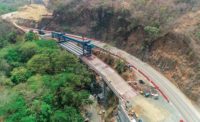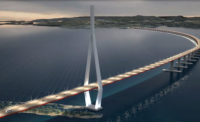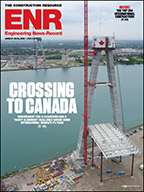
Despite some global upheavals and uncertainty, the world construction market showed surprising strength for large contractors in 2011. After being flat in 2009 and 2010, revenue for large international contractors grew last year. However, big contractors working in the international market are expressing some caution about what the future holds.
The strength of the international market in 2011 can be seen in the results of ENR's Top 225 International Contractors list. As a group, the Top 225 generated $453.02 billion in 2011 contracting revenue from projects outside their home countries, up a healthy 18.1% from in 2010.
Part of this surge may have come from pent-up demand from a stagnant market over the past three years. Combined revenue from the ENR Top 225 reached $382.44 billion in 2008 revenue, inched higher to $383.78 billion in 2009 and then dropped to $383.66 billion in 2010.
There was some tumult among the Top 225 in the past year. Most significant was Spain's Grupo ACS's effective takeover of Hochtief AG, despite Hochtief's resistance. ACS achieved majority ownership of the German giant in spring 2011.
 |
| STIELER |
Since the acquisition, there has been "a much higher focus on infrastructure" centered on transportation, urban development and energy, says Stieler. He is skeptical about prospects for new nuclear-power work and believes renewable energy has a big future. Hochtief is investing in offshore wind farms, both as a developer and contractor. At the same time, Hochtief is reducing its interest in building construction. The sector has "much lower market-entry hurdles, [so] competition is more aggressive," says Stieler.
Another takeover battle is being waged in Italy. In a July proxy battle, the Salini family, which owns Salini Costruttori SpA, was able to use its 30% stake of Impregilo SpA and a shareholder campaign to take over Impregilo's board of directors from the Gavio family, which also owns about 30% of Impregilo's stock. Salini has been campaigning to merge the two large Italian contractors, but lawsuits over the shareholder vote may delay any final decision.
Because of the debt crisis, "the situation in Europe has deteriorated," says Yves Gabriel, chairman and CEO of France's Bouygues Construction. But for Bouygues, the French market "is stronger than in other European countries." While demand is high in the Paris region, elsewhere "large contracts remain few and far between," Gabriel notes.
France accounts for over half of VINCI Construction's business. "We have been growing and our backlog is still higher," says VINCI's chief operating officer, Bruno Dupety.
Oil-rich Norway is booming, and projects there "are getting more and more complex," says Johan Karlström, president and CEO of Sweden's Skanska A.B. "There is growing interest from international competition," he adds. However, he notes there has been a lull in civil construction orders from Sweden. "All the major players from Europe are here," he says.








